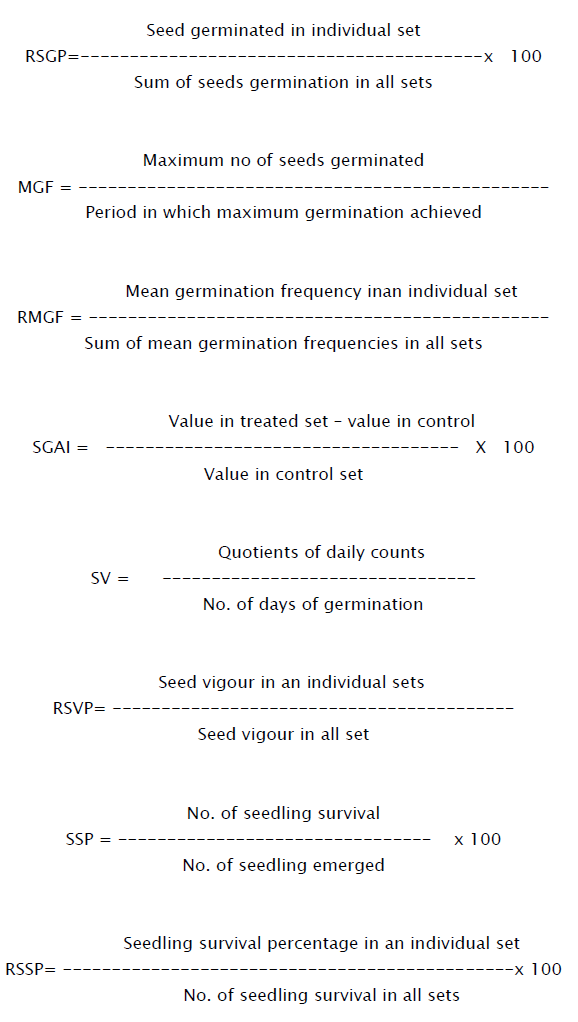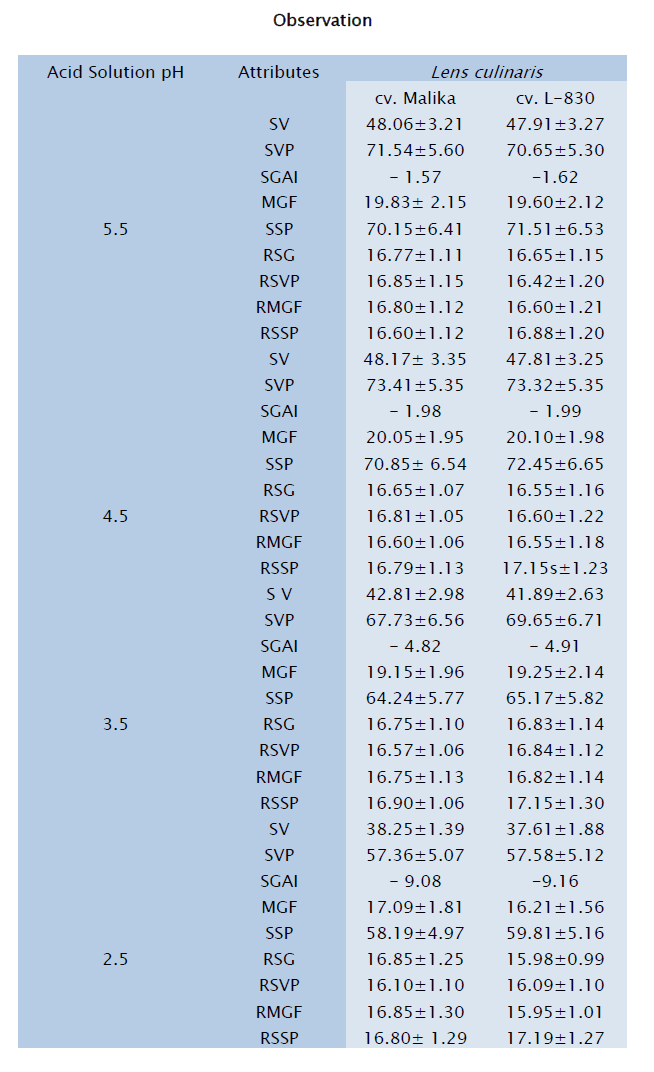ISSN: 2320-0189
ISSN: 2320-0189
Atoura UMV, Atoura, Mavana, Merrut, Uttar Pradesh, India
Department of Biotechnology and Microbiology, Doon (PG) Paramedical College, Dehradun, Uttarkhand, India
Received date: 13 April 2013 Accepted date: 31 May 2013
Visit for more related articles at Research & Reviews: Journal of Botanical Sciences
Simulated acid rain affected seed vigour, relative seed vigour percentage, seeding survival percentage and other related attributes in two cultivars of Lens culinaris. Treatment consist of four acidic levels in simulated acid rain pH 2.5,3.5,4.5 and 5.5.Effect of different pH of acid rain on germination, seed germination, seed germination action index, mean germination frequency etc. on cvs. malika and L-830 of Lens culinaris was studied. High acidic levels were found to be inhibitory for survival of seeding and adversely affected other attributes.
Acid rain, pH, Lens culinaris
Rain is most important source of fresh water from time immemorial. The rain which is more acidic (lower pH) than the normal is known as acid rain.SO2 is generally produced due to industrial activities like combustion of fossil fuel (coal etc.)refining of crude petroleum and smelting of sulphur containing ores etc. resulting into formation of SO2 which after oxidation of sulphur and many sulphides by the pyrolysis in the air of sulphides and thiosulphites,results into acid rain which are known to affect vegetation, forestry, crops and fauna etc. making studies on acid rain logical. Verma [11] observed the effect of simulated acid rain on some leguminous species and found that starting from seed germination till the fruiting .All the process are adversely affected .Some results have been reported by Singh [10] and Anita et. al. [3] leaving enough scope of further studies on leguminous crops. Hence, the present studies were undertaken.
Lens culinaris soaked in distilled water for 2 hrs. and then surface sterilized with 0.001M mercuric chloride solution for 2 minutes of pH 2.5, 3.5, 4.5, and 5.5 were achieved with a combination of sulphuric acid & nitric acid (7.3v/v) in distilled water. One hundred seeds of each variety were germinated in petri-plates packed by a thin layer of absorbed cotton and filter paper, 125 ml of simulated acid rain solution was gently poured over each set. The emergence of radicle to 1-2mm length was considered as successful germination and germinated seeds were counted everyday till further no germination occurred and it was six days period after which no new germination was noticed from the data thus obtained.
Seed germination percentage (SGP),Relative seed germination percentage (RSGP), mean germination frequency (MGF), Relative mean germination frequency (RMGF), seed germination action index (SGAI), relative seed vigour percentage (RSVP), seedling survival percentage (SSP),relative seedling survival percentage (RSSP).
Methods and formulae used to study the above parameter are as follow:


Observation made on the stress of acid rain on two cultivars of Lens culinaris indicated that simulated acid rain had most harmful affect on different attributes. Seed vigour maximally reduced at pH 2.5 in cv. L-830 , seed vigour percentage also get reduced .Seed germination action index in both cultivars indicate both positive & negative values .Positive values show stimulatory effects while negative values show inhibitory effects of the treatments.q
Mean germination frequency also show significant reduction in cvs. malika at pH 2.5. Seedling survival percentage had no significant alteration in comparison to control at pH 4.5. Observation regarding RSG, RSVP, RMGF and RSSP showed a tendency towards an increase at higher pH and decrease at lower pH except pH 4.5. Acid rain pH may inhibit the pH dependent enzymatic activities thus affecting seed germination and related parameters [8]. The present experimental findings also coincide with those of Adaros et.al. [1], Anderson et.al. [2], Kumar [7].
According to Mohan and Kumar [6], the probability of acid rain occurrence in India is about 2% .This is sufficient enough to reduce the productivity of vegetation and yield of our crops by several folds. The present investigation has been undertaken to know the impact of acidity on legumes which besides being a good source of food also contribute to the fertility of soil .The present experimental findings are in concurrence with those of Garg [4], Shripal and Kumar [9] and Graham H P et. al.[5].
